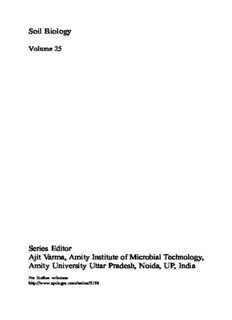
Diversity and Biotechnology of Ectomycorrhizae PDF
Preview Diversity and Biotechnology of Ectomycorrhizae
Soil Biology Volume 25 Series Editor Ajit Varma, Amity Institute of Microbial Technology, Amity University Uttar Pradesh, Noida, UP, India For furthervolumes: http://www.springer.com/series/5138 . Mahendra Rai Ajit Varma l Editors Diversity and Biotechnology of Ectomycorrhizae Editors MahendraRai,Ph.D. Prof.Dr.AjitVarma ProfessorandHead DirectorGeneral DepartmentofBiotechnology AmityInstituteofMicrobialTechnology SGBAmravatiUniversity AmityUniversityUttarPradesh Amravati444602,Maharashtra &ViceChairman India AmityScience,Technology&Innovation [email protected]; Foundation [email protected] BlockA,AmityCampus,Sector125 Noida,UP201303 India [email protected] ISSN1613-3382 ISBN978-3-642-15195-8 e-ISBN978-3-642-15196-5 DOI10.1007/978-3-642-15196-5 SpringerHeidelbergDordrechtLondonNewYork #Springer-VerlagBerlinHeidelberg2011 Thisworkissubjecttocopyright.Allrightsarereserved,whetherthewholeorpartofthematerialis concerned,specificallytherightsoftranslation,reprinting,reuseofillustrations,recitation,broadcasting, reproductiononmicrofilmorinanyotherway,andstorageindatabanks.Duplicationofthispublication orpartsthereofispermittedonlyundertheprovisionsoftheGermanCopyrightLawofSeptember9, 1965,initscurrentversion,andpermissionforusemustalwaysbeobtainedfromSpringer.Violations areliabletoprosecutionundertheGermanCopyrightLaw. Theuseofgeneraldescriptivenames,registerednames,trademarks,etc.inthispublicationdoesnotimply, evenintheabsenceofaspecificstatement,thatsuchnamesareexemptfromtherelevantprotectivelaws andregulationsandthereforefreeforgeneraluse. Coverdesign:SPiPublisherServices Printedonacid-freepaper SpringerispartofSpringerScience+BusinessMedia(www.springer.com) DedicatedtomyreveredteacherProfessorR.C.Rajak,Ex-headandDean, DepartmentofBio-Sciences,RDUniversity,Jabalpur,MadhyaPradesh,India –MahendraRai . Preface Roots–thehiddenhalfoftheplants–areimportantorgansforabsorptionofwater and nutrients from the soil. Roots release many carbon compounds as exudate. These compounds provide support to develop a symbiotic relationship with soil- borne fungi, often called as mycorrhiza. The fungal partner (mycobiont) provides theplantwithimprovedaccesstowaterandnutrientsinthesoilduetoaprofusely branchedhyphalnetworkthatspreadsfromtherootsurfaceandextendsfarintothe soil.Theplant,inreturn,suppliescarbohydrateforfungalgrowthandsurvival.The mycorrhizaeingeneralandectomycorrhizae(ECM)inparticulararemorebenefi- cialtotheplantsgrowinginnutrient-poorsoil.Ectomycorrhizalplantsareresistant tosoil-bornediseasesandoftentoleratedroughtstress.Infact,theECMisrespon- sibleforthesuccessionofecosystems. Thereisenormousdiversityofectomycorrhizalfungiinaforest.TheECMcan beused asindicatorsofqualityandalsoforthe developmentofforestecosystem. ECM could be applied for reforestation as they accelerate the plant growth by supplying water and nutrients. Interestingly, without ECM, healthy woodland communitycannotbemaintained.Moreover,someectomycorrhizalfungiproduce ediblesporocarps(fruitingbodies),whichareeatenbythepeopleandthusimpor- tantforthefoodindustry. Forbetterperformanceoftheplants,itisnecessarytoinoculatethematseedling stage by ECM to make their life safe. ECM plays a multifunctional role during symbiosis with higher plants. These fungi have diverse roles as bioremediators, bioprotectors, biofertilizers, and stress indicators. They are the true “mycoindica- tors”oftheforestecosystem.Therearemanymetalchelatingmoleculesproduced by ectomycorrhizal fungi, which have remarkable biotechnological significance. Furthermore,ECMsecretesimportantsecondarymetabolites. Molecular approaches are very important for the identification and differentia- tion of the fungi forming symbiosis with higher plants. Molecular tools are also importanttounderstandhowthegenesareexpressedduringsymbiosiswithhigher plants. The ectomycorrhizal fungi can be transformed by using Agrobacterium tumefaciens. vii viii Preface The main goal of this book is to provide information to the readers regarding diversityandapplicationsofectomycorrhizaeandtheuseofmodernbiotechnologi- caltoolsinunderstandingandtransformingthem. The volume is divided into three parts, viz. (1) diversity, morphology, and applications, (2) biotechnological aspects of ectomycorrhizal fungi, and (3) func- tions and interactions. The whole book has been made user-friendly and worth reading. Part I includes three chapters, out of which the first chapter explains how ectomycorrhizal inoculation benefits the members of family diptercarpaceae. The second chapter discusses the status of ectomycorrhizal fungi in South America, whilethethirdchapterdealswithinoculaandthetechniquesofinoculationintothe hostplants. PartIIincorporatesthe molecularapproachesinthe systematicsofECM,gene expression during symbiosis, Agrobacterium-mediated gene transfer, biotechno- logicalprocess,andsignalinginECMsymbiosisandRNA-silencing. In Part III, ectomycoremediation, functions of ECM when challenged with heavymetals,scaleissuesconcerningtheroleofECMinfunctioningofecosystems as indicators of stress in forests, effect of pesticides on ECM, their secondary metabolites, carbon and nitrogen interactions, interaction of Cantharellus with Dendrocalamus,andedibleectomycorrhizalfungihavebeenincluded. This volume would be of utmost importance to students, researchers, and teachers of botany, mycology, microbiology, forestry, and biotechnology. The readersshouldfindthebookfullofinformationandreaderfriendly. Inplanning thisvolume, invitationsfor contributionswere extended toleading international authorities working with ectomycorrhizae. The editors would like to express sincere appreciation to each contributor for his/her work and for their patienceandattentiontodetailduringtheentireproductionprocess.Wesincerely hopethattheseeminentcontributorswillencourageusinthefutureaswell,inthe greatestinterestoftheacademia. We are extremely grateful to the staff members of Springer Heidelberg, espe- cially Hanna G. Hensler-Fritton, Editorial Director Life Sciences/Biomedicine EuropeII,DieterCzeschlik(nowretired),andJuttaLindenbornfortheircontinued interest, critical evaluation, constructive criticism, and support. We wish to acknowledgethehelpandsupportgiventousbyourstudents,facultycolleagues, andfamilymembersfortheirconstantencouragement. Amravati,Maharashtra,India MahendraRai Noida,UttarPradesh,India AjitVarma Contents PartI Diversity,MorphologyandApplications 1 TheImportanceofEctomycorrhizasfortheGrowth ofDipterocarpsandtheEfficacyofEctomycorrhizal InoculationSchemes ....................................................... 3 FrancisQ.Brearley 2 TheEctomycorrhizalSymbiosisinSouthAmerica:Morphology, Colonization,andDiversity ............................................... 19 AlejandraG.BecerraandMarceloR.Zak 3 EctomycorrhizalInoculumandInoculationTechniques .............. 43 IvanRepa´cˇ PartII BiotechnologicalAspectofECM 4 SystematicsandEcologyofTropicalEctomycorrhizalFungi UsingMolecularApproaches ............................................. 67 Rivie`re-DobignyTaiana 5 TheMolecularEctomycorrhizalFungusEssenceinAssociation: AReviewofDifferentiallyExpressedFungalGenesDuring SymbiosisFormation ...................................................... 87 BartolomeuAcioli-Santos,HelderEl´ısioE.Vieira,Cla´udiaE.P.Lima, andLeonorC.Maia 6 Agrobacteriumtumefaciens-MediatedTransformation ofEctomycorrhizalFungi ............................................... 123 MinnaJ.Kemppainen,MariaC.AlvarezCrespo,andAlejandroG.Pardo ix x Contents 7 BiotechnologicalProcessesUsedinControlledEctomycorrhizal Practices .................................................................. 143 ParDuponnoisRobin,Baˆ Amadou,MousainDaniel,GalianaAntoine, BaudoinEze´kiel,DreyfusBernard,andPrinYves 8 SignalinginEctomycorrhizalSymbiosisEstablishment .............. 157 PaulBaptista,RuiManuelTavares,andTeresaLino-Neto 9 RNASilencinginEctomycorrhizalFungi .............................. 177 MinnaJ.KemppainenandAlejandroG.Pardo PartIII FunctionsandInteractions 10 Ectomycoremediation:AnEco-FriendlyTechnique fortheRemediationofPollutedSites ................................. 209 HeikeBu¨cking 11 MetalElementsandtheDiversityandFunction ofEctomycorrhizalCommunities ..................................... 231 AlexanderUrban 12 AConceptualFrameworkforUp-ScalingEcologicalProcesses andApplicationtoEctomycorrhizalFungi ........................... 255 VirgilIordache,ErikaKothe,AuroraNeagoe,andFeliciaGherghel 13 MycobioindicationofStressinForestEcosystems ................... 301 HojkaKraigherandSamarAlSayeghPetkovsˇek 14 EffectsofPesticidesontheGrowthofEctomycorrhizalFungi andEctomycorrhizaFormation ....................................... 323 MiguelMarin 15 Metal-ChelatingAgentsfromEctomycorrhizalFungi andTheirBiotechnologicalPotential .................................. 347 A´ngelaMachuca 16 EctomycorrhizaandSecondaryMetabolites ......................... 371 HannaDahmandPatrycjaGolin´ska 17 C:NInteractionsandtheCost:BenefitBalance inEctomycorrhizae ..................................................... 387 AnaCorreˆaandMaria-Ame´liaMartins-Louc¸a˜o
Description: